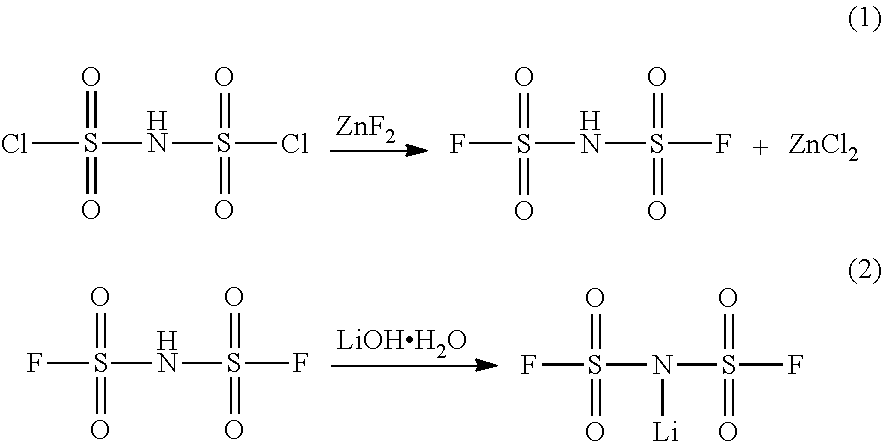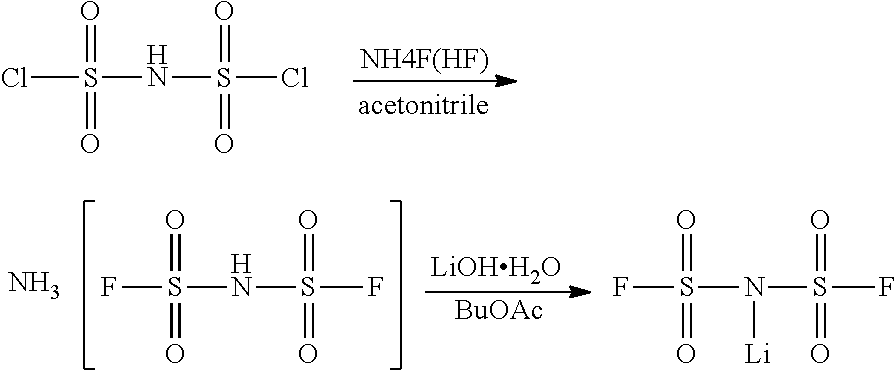Novel method for preparing lithium bis(fluorosulfonyl)imide
a technology of fluorosulfonyl and lithium bis, which is applied in the direction of electrochemical generators, organic chemistry, nitrogen and non-metal compounds, etc., can solve the problems of large amount of wastewater containing, high cost of zinc fluoride, and large amount of poorly soluble zinc components. achieve the effect of high yield and purity
- Summary
- Abstract
- Description
- Claims
- Application Information
AI Technical Summary
Benefits of technology
Problems solved by technology
Method used
Image
Examples
example 1
Production of Anhydrous Ammonium Fluoride (NH4F)
[0049]To a 500-mL flask equipped with a stirrer, a condenser and a thermometer, 100 g of commercial ammonium fluoride (purity: 96%; a water content of 3.6% as measured by Karl Fischer analysis) and 120 g of acetone were added and stirred at room temperature for 3 hours. Then, the acetone slurry of stirred ammonium fluoride was filtered through filter paper, and ammonium fluoride collected on the filter paper was collected in a 250-mL round-bottom flask. Next, the remaining acetone was evaporated under reduced pressure (10 Torr) at 40° C. and dried, thereby obtaining 93 g of anhydrous ammonium fluoride as a white crystal.
[0050]The obtained product had a water content of 760 ppm as measured by Karl Fischer analysis and was used in reaction.
example 2
Production of Ammonium Bis(Fluorosulfonyl)Imide
[0051]2-1. Use of Anhydrous NH4F / Treatment with Li2CO3 Powder
[0052]To a 1,000-mL fluororesin container equipped with a stirrer, a condenser and a thermometer, 34.2 g of anhydrous ammonium fluoride and 450 g of butyl acetate (water content: 80 ppm) were added at room temperature under a nitrogen atmosphere. While the mixture was stirred, 50 g of bis(dichlorosulfonyl)imide was added slowly thereto. Next, the mixture was allowed to react while being heated to 80° C., thereby producing bis(fluorosulfonyl)imide.
[0053]After completion of the reaction, the temperature was lowered to 60° C., and 17.1 g of Li2CO3 powder was added slowly to the reaction product and allowed to react. Thereafter, the reaction product was cooled to room temperature, and the generated salt was filtered using filter paper. The filtered butyl acetate layer was concentrated under reduced pressure, thereby obtaining white powder. IR analysis and elemental analysis showed...
example 3
Production of Lithium Bis(Fluorosulfonyl)Imide from Ammonium Bis(Fluorosulfonyl)Imide
[0060]To a 1,000-mL round-bottom flask equipped with a stirrer, a condenser and a thermometer, 30.0 g of ammonium bis(fluorosulfonyl)imide, obtained in Examples 2-1 to 2-4, and 300 g of butyl acetate, were added at room temperature under a nitrogen atmosphere. The mixture was stirred at room temperature for 30 minutes, and an aqueous solution of lithium hydroxide hydrate (LiOH.H2O) was added thereto in an amount of 2 equivalents, followed by further stirring for 60 minutes.
[0061]After completion of the reaction, the reaction product was separated into a butyl acetate layer and an aqueous layer by use of a separatory funnel. The obtained butyl acetate layer was concentrated under reduced pressure at 80° C. or below until the remaining solvent amount reached 5 wt % or less based on the weight of the crude product, thereby obtaining a pale yellow concentrate. To the obtained concentrate, a 3-fold weigh...
PUM
| Property | Measurement | Unit |
|---|---|---|
| water content | aaaaa | aaaaa |
| water content | aaaaa | aaaaa |
| temperature | aaaaa | aaaaa |
Abstract
Description
Claims
Application Information
 Login to View More
Login to View More - R&D
- Intellectual Property
- Life Sciences
- Materials
- Tech Scout
- Unparalleled Data Quality
- Higher Quality Content
- 60% Fewer Hallucinations
Browse by: Latest US Patents, China's latest patents, Technical Efficacy Thesaurus, Application Domain, Technology Topic, Popular Technical Reports.
© 2025 PatSnap. All rights reserved.Legal|Privacy policy|Modern Slavery Act Transparency Statement|Sitemap|About US| Contact US: help@patsnap.com



